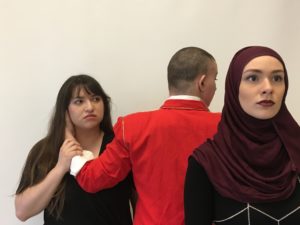All-female Anjou offers a mixed portrayal of an English queen, with performances from talented young actresses

Reviewed by Ryan Pepper
It’s taken four hundred years since the Lord Chamberlain’s Men performed Richard III for a damning look at Richard’s wife and former queen Margaret of Anjou to appear on stage. The Lady Chamberlain, a troupe of young actresses, have given the English queen and wife of Henry VI a not-entirely-flattering portrait as a queen who fails to stand against the usurper Richard’s villainy.
The play is divided into multiple short scenes, and the play, while progressing chronologically, has a disjointed feel to it. Given the time restrictions of Fringe, there are no filler scenes, and many scenes that could have helped flesh out the play were removed in favour of jumping from important event to event. It isn’t bad, per se, but does take away from some of the immersion that we might expect from a longer work. The wedding scene, for instance, depicting the marriage of Anne and Richard III, was over in a minute, and the scene had no dialogue, just violin music. The following scene focuses on the rocky relationship between Anne and her former mother-in-law Margaret, and while their relationship is more important than the wedding, filling out the wedding scene would have elevated the play’s overall level of artistry.
The memorization of lines was impressive, especially given the lengthy soliloquizing nature of many scenes. Margaret’s opening scene was a prolonged monologue on the Queen’s powerlessness, the loss of her title, and her grief at the death of her husband and son. She turns to Tarot cards to divine the fall of Richard, and throughout the play, we see her inability to fight against the tyrant king, instead resorting to fortune telling. Margaret is not a strong woman, and she becomes hard to sympathize with, as she continues to fail to oppose Richard’s cruelty. As a suffering woman, the performance shined in the soliloquys but lacked some depth in dialogue scenes; the same can be said for Richard, who could have been just a little more villainous.
Anjou in its current form is a good new effort from young actresses and playwrights, and if this early play is any indication, the Lady Chamberlain will become an impressive group in Ottawa in no time. Anjou, though, does seem like a work-in-progress, and it feels like the restrictions of Fringe are holding it back. As a 60-minute drama it’s worth the watch, but if the Lady Chamberlain undertook to expand the play, it would certainly become a powerful piece of original Ottawa theatre.
At Arts Court Theatre